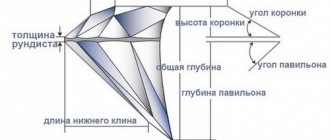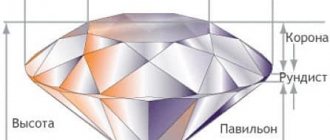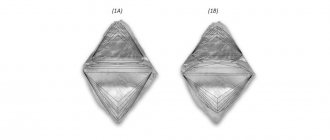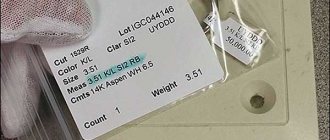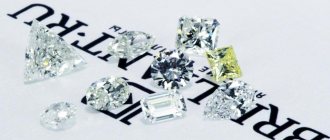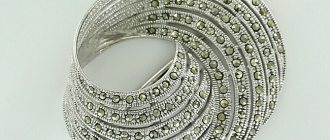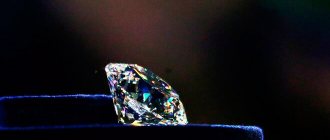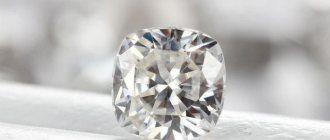What is carat
Historians believe that stones were measured in carats already in ancient times. But initially they used the seeds of a cereal plant, which had approximately the same weight.
Gradually, the seeds were replaced by a coin weighing 24 Ceratonia. It was used during the reign of Emperor Constantine in ancient Greece. It is worth assuming that it was the ancient Greeks, in an effort to find the answer to the question of how to find out how much certain stones weigh, who initiated the emergence of a new unit of measurement.
Until the 19th century, there was no single equivalent to the carat. The generally accepted meaning was established only at the beginning of the 20th century. To this day, a metric carat is equal to 0.2 grams.
How much does a one carat standard diamond weigh? This is traditionally 200 milligrams, the same 57 sides and a diameter of 6.4 mm. The stone sparkles brightly in the sun. The ability to refract light rays is called brilliantity.
A 2-carat solitaire is visually almost indistinguishable from a one-carat solitaire. The main difference is the price. It costs much more, since its diameter is 8.2 mm, and the play of light becomes inimitable. Large diamonds are used in designer items more often to order.
High-precision carat scales can help determine the mass of tapeworm. You can also determine the carat of a diamond by size using a simple analysis of parameters. You need to understand that the carat weight is related to the cut shape. It should be taken into account that the weight of the stones is not a decisive factor in the matching of sizes.
Most often, jewelry craftsmen give diamonds a round shape. It is believed that with this cut, the solitaire has more opportunities to demonstrate the play of light.
Carat gold
The amount of pure gold in an item can be determined using karat. In the USA and European countries, only gold alloys are valued in carats.
A carat of gold is the ratio of pure metal to 24 parts of the substance. For example, 9 carats is the 375th sample. It means that the alloy contains 37.5% precious metal.
Products may be marked 14 K, 18 K, 24 K. The numbers indicate the share of gold, and the remaining share, subtracted from 24, is the auxiliary components.
Carats can be converted to the metric system. We divide the marking by 24 and get a sample. For example, the marking is 18 K. You need to divide 18 by 24, you get 0.75, that is, the 750th standard of Russian gold.
In Russian stores, the most famous sample is 585. This means that a kilogram contains 585 grams of precious metal, and the rest is an alloy. Pure gold is 999 purity. It is produced only in the form of ingots, and it cannot be made into jewelry, since the metal is too soft.
There are other samples of gold, but they are rarely used. Silver is valued in the same way.
About the relationship between parameters - tables
Let's look at the size and weight of a round diamond:
| Diameter, in millimeters | 4,1 | 5,1 | 6,4 | 8,2 | 9,4 | 10,4 | 11 | 14 |
| Weight | 0,25 | 0,5 | 1 | 2 | 3 | 4 | 5 | 10 |
Square-shaped solitaires are called “usher” and “princess”. Using the table, you can easily understand how to determine the size of a diamond in carats in this design:
| Diameter, mm | 3,3 | 4,45 | 5,55 | 7,05 | 8,05 | 8,85 | 9,5 |
| Weight | 0,2 | 0,5 | 1 | 2 | 3 | 4 | 5 |
Exclusive shape specimens have the greatest error. The table shows data for a 1 carat diamond depending on its shape.
| Form | Marquis | Heart | Oval | Emerald | Pear |
| Dimensions | 9.8x5.6 | 6.7x6.5 | 7.7x5.9 | 6.4x4.9 | 8.6x5.8 |
How many grams are in one carat of jewelry?
You can determine the weight of a gem yourself; there are several ways to do this.
Diameter to weight ratio
You can find out the weight by diameter if you are dealing with round gems. A special table shows the ratio of the mass of the stone and its diameter. For example, 1 carat is how much in diameter:
- 1 millimeter – 0.005 carats;
- 2 mm – 0.003;
- 3 mm – 0.1;
- 4 mm – 0.25;
- 5 mm – 0.5.
The larger the diameter of the gem, the higher its mass. Here you should also take into account the type of cut, since an oval cut will require less material than a classic round cut.
Calculation of gem weight relative to cut
In the absence of scales, minerals are measured using their length, width and cut. Here are some excerpts from the table for determining weight by cut:
- Round. The squared diameter is multiplied by the height of the stone, by its density and a coefficient of 0.0018.
- Marquis. Length multiplied by width, height, density and a factor of 0.0016.
- Round cabochon. The diameter is multiplied by the density of the stone and a coefficient of 0.00259.
Attention! When using this method, you must always take into account possible defects and add 3-6% of the resulting mass to the convexity of the stone.
The price of a 1 carat diamond: what it depends on
Determining the mass and diameter indicators is not enough to indicate the final cost. Quality also matters. A tapeworm that best meets the requirements for the main parameters is more expensive. The price of some specimens of just 1 carat amounts to several thousand dollars. Stones with minor defects and the same parameters will cost two or even three times less. A stone with serious damage can be purchased for no more than $1,000.
In the jewelry world, it is practiced to evaluate stones in accordance with an established system, it is called 4 C. The following indicators are taken into account:
- color (color) - associated with the components included in the composition, is preserved and does not change over time;
- cut level;
- purity is analyzed at 10x magnification;
- mass (carat).
The final assessed value is added up according to Tavernier's rule. Use a calculator to calculate. Use it to multiply the carat cost data with the square of the weight. You can follow a pattern: a 2-carat solitaire will be twice as expensive as a one-carat diamond, and a 10-carat diamond is 100 times more expensive than a one-carat diamond. Large exclusive specimens of more than 20 carats are very rare. All of them are kept in private collections, museums, and put up for sale under their own names.
Round Diamonds – How to Divide them
Round diamonds are grouped according to the quality of their finish. These can be group stones:
- A – flawless specimens;
- B – high rating;
- B – rating “good”;
- G – means “satisfactory”.
The large solitaire with a high level of finishing shines especially brightly. In turn, small diamonds play with light almost imperceptibly. Round solitaires, unlike square and fancy-shaped stones, in addition to powerful brilliants, have sparkle, for which they are valued higher. Such solitaires attract attention, shimmering with all the colors of the rainbow and emitting an inner glow.
Where did the concept come from?
Initially, in different countries and even parts of the world, precious stones, like many others, were measured in proportion to the weight of cereal grains. The cereal crop was chosen as follows: it had to be common to the area, and most of the grains had to be of the same weight. In Europe, barley grain was used for such a standard, since it was the smallest in size. Precious stones most often came from the East, so the plant that was used to measure their weight is much more logical to look for there.
Correspondence between carat and diamond size
According to one theory, the word “carat” is associated with the seeds of the acacia tree, which is often found in Mediterranean countries. Such seeds have approximately the same weight and size, and the Greek name for this plant is similar to the word “karat”. There is another version of the origin of the word. It supposedly originates from the local name of the coral tree, the average weight of a seed of which is also approximately equal to one carat. This version is considered less likely.
Among the Greeks, acacia seeds served as a weight to measure the weight of gold. The solidus gold coin, which was issued during the reign of Constantine, had a weight proportional to 24 such seeds. But this story most likely relates to another consonant concept of karat, which means a measure of the purity of the metal.
How and with what to wear correctly
Having a diamond, even the largest and most beautiful, is not enough to truly shine, attracting the gaze of others. There are certain rules when wearing a tapeworm. The larger the diamonds, the less they need proximity.
In the 21st century, there are no special requirements for wearing gemstones. The main thing is that it is beautiful, stylish, elegant. A young lady can safely wear a large diamond and no one has the right to judge her for it. However, it is believed that large stones suit mature people, while young creatures can only emphasize the natural beauty and naturalness with diamonds of 0.5 carats, one or two carats.
- The ideal tandem is diamond and platinum or white gold. Noble metals harmonize with the sparkling surface of the stone, emphasizing the ability to play with light. Yellow gold and red metals visually give the stone a yellowish appearance, which is not always effective.
- The larger the diamond, for example, 3 carats, 5 or even 10, the simpler and lighter the setting should be. In this case, nothing will overshadow the stone, and the overall impression of the composition will not be spoiled by the illusion of bulkiness. A combination of natural solitaires with fur and the same natural fabrics, for example, silk or satin, is considered successful.
- Jewelry with diamonds does not combine at all with any jewelry or sparkling decor. Such combinations are a sign of bad taste. Sparkling solitaires should be the only similar element of the look and be complemented only by jewelry with the same stones in the form of elegant sets.
- The combination of sparkling stones with dark-colored clothing is considered the most advantageous, with the exception of purple.
- It is not recommended to combine a ring with a precious stone with other rings. The exception is a modest wedding without a stone. Earrings with 1 carat diamonds can be worn in everyday life. It is better to save large stones in jewelry for special occasions.
- A necklace must be worn with a neckline and exclusively as the main element of an evening look. There are certain rules for wearing diamond-encrusted brooches. They will ideally complement a monochromatic outfit and are suitable for creating a spectacular everyday or festive look.
Did you like the article? Tell your friends on social networks how to correctly estimate the cost of a stone and how the carat relates to other parameters. Check out some useful tips on how to wear sparkling diamonds without looking vulgar or, conversely, getting lost in the crowd! See you again!
Team LyubiKamni
Measurement systems of different countries
Until the beginning of the 20th century, there was no unified system for measuring the weight of precious stones. Each “point of sale” of expensive minerals around the world used its own measure. Because of this, confusion arose when trying to determine the value of the gem, because the difference in weight sometimes reached 0.026 grams, which is quite significant. In Russia, since 1922, it has been generally accepted that 1 carat is 200 mg or 0.2 g.
Metric carat
In 1907, in Paris, the IV General Conference on Weights and Measures adopted the official weight measure for precious minerals and pearls - the carat, which was equivalent to 0.2 grams or 200 mg. The metric carat quickly became the standard jewelry measure for most countries.
English carat
In England, the local measure for the weight of gems was 205.4 mg. The entire weight system of the country, including jewelry, was based on the troy pound, the main English unit. This unit in turn was divided into several others, ultimately resulting in a troy grain equal to 64.79 mg. A carat was equal to 3.17 troy grains until 1888. Afterwards, the Ministry of Commerce determined the weight of the English measure as 205.3 mg. Since 1914, England has used the world metric system.
Also read: Jewelry with Amazonite
Arabic carat
The canonical karat or qirat was used throughout Iraq. There, the jewelry unit of measurement was equal to 1/14 of the weight of the local silver coin - the dirham, which is proportional to 223.2 mg. The Kirat of Syria, Egypt and Mecca differed significantly in weight, answering 195 mg. At the same time, the Egyptian qirat was put in relation to its own measures of weight - bakila and shamuna. The Kyrat of Asia Minor was also different, equaling 204 mg.
Alternative weights
In addition to the generally accepted carat weight system, jewelers use the following terms:
- Jewelry gran is a unit equal to ¼ carat or 50 mg. Today it is no longer used. Previously, the weight of pearls was determined using grains.
- Gram is a unit used in purchase and sale transactions of raw materials. In jewelry making, it is important to know how many grams are contained in one carat in order to estimate the approximate weight of the stone that can be obtained from this raw material.
- Momme is a measure of weight that is used only by the Japanese to measure the mass of pearls. Momme is 18.75 carats.
The carat of a stone is one of the main criteria for assessing the value of a precious mineral. Therefore, to set the price of a gem, measurements are carried out with maximum accuracy. In abbreviated form, the carat value of a stone is denoted “ct”.
